|
|
|
Sort Order |
|
|
|
Items / Page
|
|
|
|
|
|
|
| Srl | Item |
| 1 |
ID:
117740
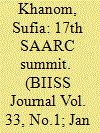

|
|
|
|
|
| Publication |
2012.
|
| Summary/Abstract |
This paper attempts to analyse the discussed issues and outcomes of the seventeenth SAARC Summit which took place in the Maldives from 10-11 November 2011 with a special reference to Bangladesh in the context of regional cooperation. Several significant and strategically important agreements were signed during this Summit with the intention to begin a new era of cooperation among the member countries. Therefore, the Summit declaration adopted several treaties like SAARC Agreement on Rapid Response to Natural Disasters, SAARC Seed Bank, SAARC Agreement on Multilateral Arrangement on Recognition of Conformity Assessment, and the SAARC Agreement on Implementation of Regional Standards. The agreements focused on enhancing and facilitating regional transit and connectivity, economic growth, ensuring energy security, combating terrorism and human trafficking and fight climate change. Though the Summit has come up with some promising mutual agreements, its success will depend on their proper and timely implementation. The lack of political will, problem of poor governance, weak economy and disparity, crisis of political leadership, ethnic, socio-cultural and religious divisions, challenges of non-state actors, transnational security challenges are considered to be the major hindrances to the success of regional integration. The South Asian region should develop its own short, medium, and long-term strategies for economic integration where each stage should be implemented effectively before moving on to the next in order to build a sound foundation for progress. The inclusion of China as 'dialogue partner' would help SAARC to make the tangible progress for regional cooperation in South Asia. The new focus on regional integrations is likely to create exciting opportunities for Bangladesh if it can exploit the synergies based on comparative advantages, investment in cross-border infrastructure projects, address challenges in governance, environmental and social developments.
|
|
|
|
|
|
|
|
|
|
|
|
|
|
|
|
| 2 |
ID:
154338
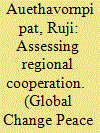

|
|
|
|
|
| Summary/Abstract |
Existing studies of Association of Southeast Asian Nations (ASEAN) states’ engagement with migrant worker rights focus on the experience of such workers from gender, labour and security perspectives. As such, these studies are yet to consider the broader impact of migrant worker rights on the process and nature of cooperation between ASEAN members. This article addresses this gap by framing migrant worker rights within the broader human rights socialization ongoing within Southeast Asia, driven by both members of ASEAN and external stakeholders. It argues that, contrary to many existing accounts of norms as creating shared commitments, migrant worker rights have led to considerable contestation, often driven by diverging national approaches to the issue. This article examines the impact of migrant worker rights norms on Thailand, the largest labour-recipient state in ASEAN. It asserts that Thailand’s diverging experience is caused by the lack of norm precision, resulting in the applicatory contestation of such norms.
|
|
|
|
|
|
|
|
|
|
|
|
|
|
|
|
| 3 |
ID:
115880
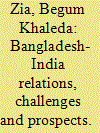

|
|
|
|
|
| Publication |
2012.
|
| Summary/Abstract |
The relations between Bangladesh and India are important and have a strong historic basis. The prospects for these relations to grow in strength are indeed enormous if they are pursued for mutual benefit and with mutual respect. Our geographical proximity, cultural affinity and shared history should form the parameters of our relations.
The challenges that confront policy makers, as well as the general public, are mostly due to negative legacies that may have their roots in our colonial past, where both our people were victims of the divide and rule policies of the Colonialists. This has created a sense of fear and distrust. There are forces in both of our societies who have played, and continue to play, on this fear psychosis to perpetuate mutual suspicion and thereby keep us apart. It is therefore imperative that we work together to lay a new foundation on which to build strong, broad-based, durable and cooperative ties, free from the thinking of the past, and generate greater trust amongst our people. In short, the need of the time is a changed mindset.
|
|
|
|
|
|
|
|
|
|
|
|
|
|
|
|
| 4 |
ID:
088713
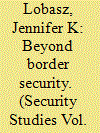

|
|
|
| 5 |
ID:
131175
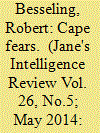

|
|
|
| 6 |
ID:
124990
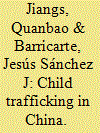

|
|
|
|
|
| Publication |
2013.
|
| Summary/Abstract |
Child trafficking is a serious problem in China. However, there has not been much research in this area. This article introduces the problem of child trafficking in China based on available data. First, the article examines the reasons for child trafficking followed by a summary description of the characteristics of the children who have been victims of trafficking. Next, the article analyzes the process of child trafficking and discusses the fate of the children involved. The article additionally provides a description of the various measures adopted by the Chinese government and NGOs (non-governmental organizations) to combat child trafficking and mentions the resistance to these measures. This article will hopefully draw the attention of the government, academia and the public to this issue.
|
|
|
|
|
|
|
|
|
|
|
|
|
|
|
|
| 7 |
ID:
122835


|
|
|
|
|
| Publication |
2013.
|
| Summary/Abstract |
While it may be intuited that human trafficking is an ineluctable component of the child soldiering experience, very little research exists to illustrate the tangible connections between these two 'worst forms' of child labour. The extent to which common reception points for trafficked children-such as slave-owning households, religious boarding schools and brothels-double as profitable reservoirs for recruiting commanders remains entirely unknown. Likewise, despite the clear financial incentive that some erstwhile commanders might have to traffic their former child combatants into civilian slavery, the prevalence of such practice is unknown. The purpose of this article is to delineate some of the most conspicuous academic gaps pertaining to the intersection of child trafficking and child soldiering.
|
|
|
|
|
|
|
|
|
|
|
|
|
|
|
|
| 8 |
ID:
069842
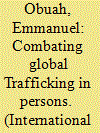

|
|
|
| 9 |
ID:
190846


|
|
|
|
|
| Summary/Abstract |
We introduce a new dataset, Contemporary Slavery in Armed Conflict (CSAC), coding instances and types of enslavement in armed conflict from 1989 to 2016, building on Uppsala Conflict Data Program data. CSAC currently covers 171 armed conflicts from 1989 to 2016, with the unit of analysis being the conflict-year. We identify different types of enslavement within these conflicts and find that 87% contained incidences of child soldiers, 34% included sexual exploitation/forced marriage, 23% included forced labor, and 16% contained instances of human trafficking. The use of enslavement in armed conflict to support strategic aims is also identified and found in about 17% of cases. Next, drawing upon key variables from the Uppsala Conflict Data Program, we present a series of cross-tabulations looking at the presence of slavery and conflict broken down by conflict incompatibility, intensity level, and type. We see the coding of slavery within conflict as a step toward generating greater understanding of when and how state and non-state actors use enslavement within conflict, with the goal of mitigating and possibly eradicating slavery in warfare.
|
|
|
|
|
|
|
|
|
|
|
|
|
|
|
|
| 10 |
ID:
127787
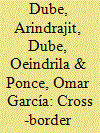

|
|
|
|
|
| Publication |
2013.
|
| Summary/Abstract |
To what extent, and under what conditions, does access to arms fuel violent crime? To answer this question, we exploit a unique natural experiment: the 2004 expiration of the U.S. Federal Assault Weapons Ban exerted a spillover on gun supply in Mexican municipios near Texas, Arizona, and New Mexico, but not near California, which retained a pre-existing state-level ban. We find first that Mexican municipios located closer to the non-California border states experienced differential increases in homicides, gun-related homicides, and crime gun seizures after 2004. Second, the magnitude of this effect is contingent on political factors related to Mexico's democratic transition. Killings increased disproportionately in municipios where local elections had become more competitive prior to 2004, with the largest differentials emerging in high narco-trafficking areas. Our findings suggest that competition undermined informal agreements between drug cartels and entrenched local governments, highlighting the role of political conditions in mediating the gun-crime relationship.
|
|
|
|
|
|
|
|
|
|
|
|
|
|
|
|
| 11 |
ID:
144735
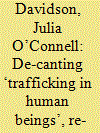

|
|
|
|
|
| Summary/Abstract |
Contemporary liberal states are eager to combat ‘human trafficking’, which state actors describe as ‘the scourge of modern slavery’ and a violation of human rights. The same states are also depriving migrants of their freedom on an unprecedented scale through immigration detention, forcibly moving them across borders through deportation, and sustaining a flourishing industry in the prevention and control of human movement. This is not a paradox. The ambition to eradicate ‘slavery’, as much as the desire to severely restrict freedom of movement, reflects a concern to preserve and extend state powers, in particular its monopoly on violence and on the control of mobility.
|
|
|
|
|
|
|
|
|
|
|
|
|
|
|
|
| 12 |
ID:
109457
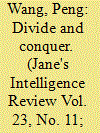

|
|
|
| 13 |
ID:
166685
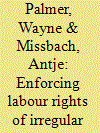

|
|
|
|
|
| Summary/Abstract |
The multi-directional nature of labour migration flows has resulted in an increasing number of countries having become both senders and receivers of regular and irregular migrants. However, some countries continue to see themselves primarily as senders and so ignore their role as a receiving country, which can have negative implications for the rights of migrants in their territory. Using the example of Indonesia, which is State Party to the 1990 UN Convention on the Rights of All Migrant Workers and Their Families, this article demonstrates that irregular migrant workers in this country have the legal right to protection against labour exploitation even when they work despite the government’s prohibition on employment. The article discusses the ‘right to work’ and how international human rights law has translated it into the ‘right to protection from labour exploitation’ for irregular migrants in Indonesia. By way of two case studies about the Indonesian government’s handling of irregular migrants, it shows how it prioritises enforcement of the employment immigration law over labour and employment laws much like countries that have not ratified the ICRMW. It also draws attention to legal protection gaps that emerge for asylum seekers when they are recognised to be genuine refugees.
|
|
|
|
|
|
|
|
|
|
|
|
|
|
|
|
| 14 |
ID:
135241
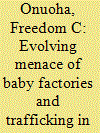

|
|
|
|
|
| Summary/Abstract |
Trafficking in persons in Nigeria has largely targeted adults and children, particularly women and girls. Of growing concern, however, is the recent emergence and growth of sophisticated and syndicated groups involved in baby ‘factories’ and trafficking in Nigeria. This article examines the nature, actors, modus operandi and motives behind this emergent dimension of human trafficking in Nigeria. It concludes that if concerted efforts are not made to deal with the actors and dismantle the market, its profitability will embolden current actors and even encourage new entrants into the booming trade – now and in the future.
|
|
|
|
|
|
|
|
|
|
|
|
|
|
|
|
| 15 |
ID:
138410
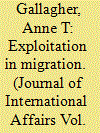

|
|
|
|
|
| Summary/Abstract |
For the millions of people who want or need to move, migration has become progressively more expensive and perilous. Legal access to preferred destinations is now an option only for the privileged few. The rest are forced into the arms of those able to help them circumvent ever-increasing controls and deterrents. Migrant smuggling, the business of moving people across borders for profit, is a sordid and dangerous enterprise, often placing lives and well-being at serious risk. And the dangers do not end there. Many of the world’s migrants find themselves deeply in debt to recruitment agencies, brokers, and sometimes their own employers before they even start work. In too many cases, these asymmetrical arrangements reach the level of human trafficking: Victims are tricked or coerced into situations of exploitation from which they cannot escape. This article argues that such practices, while unacceptable, are also inevitable. Without profound reforms to global migration regimes—and indeed to the organization of the global economy—there is likely no effective solution to migration-related exploitation. But important steps can be taken, even within the limits of current political constraints, to minimize vulnerability and harm. These include promoting political and legal acceptance of basic rights for all migrants, developing quality control systems for international labor recruitment, eliminating recruitment fees and sponsorship schemes, and co-opting civil society in an effort to increase transparency and accountability of governments and business activities.
|
|
|
|
|
|
|
|
|
|
|
|
|
|
|
|
| 16 |
ID:
089677
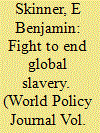

|
|
|
|
|
| Publication |
2009.
|
| Summary/Abstract |
Human trafficking may be just the latest topic du jour among U. S. humanitarian types, but mention the underlying crime- slavery to foreign officials and the rection is often confused and explosive. For God's sake, don't go talking about brutal slavery here, says Jay Kumar, the social secretary of Araria, one of the poorest districts in Bihar, the poorest state in India.
|
|
|
|
|
|
|
|
|
|
|
|
|
|
|
|
| 17 |
ID:
152653
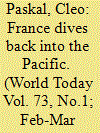

|
|
|
| 18 |
ID:
146871


|
|
|
| 19 |
ID:
150452


|
|
|
| 20 |
ID:
160335
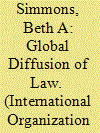

|
|
|
|
|
| Summary/Abstract |
In the past few decades new laws criminalizing certain transnational activities have proliferated: from money laundering, corruption, and insider trading to trafficking in weapons and drugs. Human trafficking is one example. We argue that criminalization of trafficking in persons has diffused in large part because of the way the issue has been framed: primarily as a problem of organized crime rather than predominantly an egregious human rights abuse. Framing human trafficking as an organized crime practice empowers states to confront cross-border human movements viewed as potentially threatening. We show that the diffusion of criminalization is explained by road networks that reflect potential vulnerabilities to the diversion of transnational crime. We interpret our results as evidence of the importance of context and issue framing, which in turn affects perceptions of vulnerability to neighbors' policy choices. In doing so, we unify diffusion studies of liberalization with the spread of prohibition regimes to explain the globalization of aspects of criminal law.
|
|
|
|
|
|
|
|
|
|
|
|
|
|
|
|
|
|
|
|
|